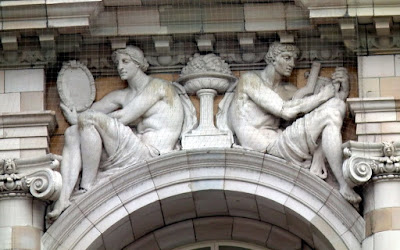The Strand facade of Somerset House was the first part of the complex to be built, in 1776. It is adorned with four allegorical figures carved by two interesting Italian artists based in 18th century London, Agostino Carlini and Giuseppe Ceracchi.

The figures, venerable Roman senators, stand in front of the attic storey right at the top, representing (from left to right) Moderation, Justice, Prudence and Valour. Carlini did the pair in the middle, Ceracchi the ones at the corners.

All wear a Phrygian cap of Liberty and hold a fasces, its tightly-bound reeds symbolising strength through unity. Moderation holds a bridle; Justice, scales; a mirror for Prudence and a sword for Valour.
Above all is the Royal Arms.
The message was clear: the British state is the new Rome, governed by rational principals for the benefit of all.
However, it must have looked very odd only a few years later when the French Revolution broke out and the Phrygian cap became for ever associated with bloody revolution, chaos and the Terror. And in the 20th century the fasces became associated with one of the nastiest ideologies of all time. Such is the danger of adopting ancient symbols for propaganda purposes in stone - you never know the company you might be keeping.


The republican symbolism was dear to the heart of Ceracchi in particular, who was a commited Jacobin. He made a bust of Napoleon as Consul and later visited America and carved a notable bust of George Washington. His end was dramatic: he saw Napoleon's transformation into an Emperor as a betrayal of the Republic and got involved in a conspiracy against the tyrant, leading to his execution in 1801. Legend has it that he went to the guillotine in a triumphal chariot of his own design.
Carlini was a much more establishment figure. He had come to London from Genoa, living in Soho (Ceracchi was staying with him while they worked on the Somerset House figures) and was a founder member of the Royal Acadamy which was then located in that very building.
The Professor of Anatomy at the Royal Academy, Dr Hunter, commissioned Carlini to make a cast of the body of an executed smuggler whose skin had been flayed. This gruesome item was exhibited as 'The Dying Gaul' with the subtitle 'Smugglerius', and copies were used to teach medical students.

Surmounting the facade is the coat of arms of George III, carved by John Bacon Senior. The shield is quartered with the harp of Ireland, the lion of Scotland and the three lions of England and the fleur-de-lys of France.
In the fourth quarter is the badge of Hanover, comprising two lions for Brunswick, another lion for Luneburg and a horse for Westfalia. Charlemagne's crown at the centre signifies George's position as Archtreasurer of the Holy Roman Empire, a title that must have given him much simple pleasure.
It must be one of the last royal coats of arms to show the fleur-de-lys, which were finally abandoned in 1801 partly because the claim to throne of France was ridiculous but also to recognise that the French throne no longer existed.
The arms are supported by figures of Fame, blowing his trumpet, and the Genius of England, who points meaningfully to a plaque below the main arms with the image of Saint George brandishing his sword as he jumps his horse over the dragon.
The group was very much admired at the time. Giuseppe Baretti in his
Guide of 1781 says "The whole is a much approved performance of Mr Bacon."
John Bacon was the son of a clothworker in Southwark who became rich and famous churning out memorials for churches. Philip Ward-Jackson has written of him: "His great abilities as a sculptor were disagreeably offset by what some saw as a smug and smarmily pious manner."
 Collcutt created the deep entrance courtyard beloved by pub quiz question-setters because it is the only street in Britain where you drive on the right. The tight roundabout at the end is said to be the reason why London's black cabs have to turn on a sixpence.
Collcutt created the deep entrance courtyard beloved by pub quiz question-setters because it is the only street in Britain where you drive on the right. The tight roundabout at the end is said to be the reason why London's black cabs have to turn on a sixpence.










